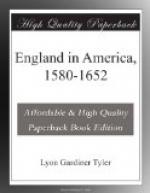One of the most remarkable results of the massacre was the change it produced in Rev. Thomas Harrison, Berkeley’s chaplain at Jamestown, who had used his influence with the governor to expel the Nonconformist ministers of New England. He came to the belief of John Winthrop that the massacre was a Providential visitation and turned Puritan himself. After a quarrel with Berkeley he left Jamestown and took charge of the churches on the Elizabeth and Nansemond rivers with their Puritan congregations. Berkeley would probably have set the law-officers upon him at once, but among his councillors was Richard Bennett, himself of Harrison’s congregation, and his influence held the governor back for a time.
Three years passed, and at length Harrison and his elder, William Durand, were peremptorily directed to leave the colony. Harrison went first to New England and then to old England, while William Durand emigrated to Maryland, where, aided by Bennett, he made terms with Governor William Stone for the emigration of his flock; and in the year 1649 more than one thousand persons left Virginia and settled on the Severn and Patuxent rivers. The settlement was called Providence, and was destined to play a remarkable part in the history of Maryland.[28]
When the civil war in England was fairly on, emigration to Virginia was much improved in material, and for many years was very large. The new-comers came to make homes, not merely to make tobacco, and they no longer consisted of servants, but of the merchants and yeomanry of England. “If these troublous times hold long amongst us,” wrote William Hallam, a salter of Burnham, in Essex County, England, “we must all faine come to Virginia."[29]
Hitherto the uncertainty resulting from the overthrow of the charter made it difficult to secure a good class of ministers. Those who came had been “such as wore black coats and could babble in a pulpet, and roare in a tavern, exact from their parishioners, and rather by their dissolutenesse destroy than feed their flocks.” Now these “wolves in sheep’s clothing” were by the assembly forced to depart the country and a better class of clergymen arrived.[30] In 1649 there were twenty churches and twenty ministers who taught the doctrines of the church of England and “lived all in peace and love";[31] and at the head of them was a roan of exemplary piety, Rev. Philip Mallory, son of Dr. Thomas Mallory, Dean of Chester.[32]
The condition of things about 1648 is thus summed up by Hammond, a contemporary writer: “Then began the gospel to flourish; civil, honorable, and men of great estates flocked in; famous buildings went forward; orchards innumerable were planted and preserved; tradesmen set to work and, encouraged, staple commodities, as silk, flax, potashes attempted on.... So that this country, which had a mean beginning, many back friends, two ruinous and bloody massacres, hath by God’s grace outgrown all, and is become a place of pleasure and plenty.”




